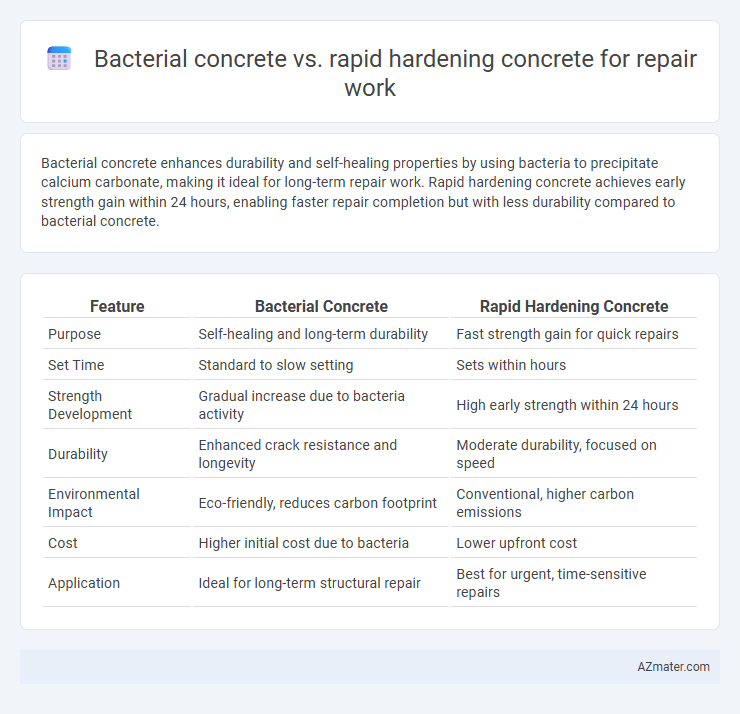Bacterial concrete enhances durability and self-healing properties by using bacteria to precipitate calcium carbonate, making it ideal for long-term repair work. Rapid hardening concrete achieves early strength gain within 24 hours, enabling faster repair completion but with less durability compared to bacterial concrete.
Table of Comparison
| Feature | Bacterial Concrete | Rapid Hardening Concrete |
|---|---|---|
| Purpose | Self-healing and long-term durability | Fast strength gain for quick repairs |
| Set Time | Standard to slow setting | Sets within hours |
| Strength Development | Gradual increase due to bacteria activity | High early strength within 24 hours |
| Durability | Enhanced crack resistance and longevity | Moderate durability, focused on speed |
| Environmental Impact | Eco-friendly, reduces carbon footprint | Conventional, higher carbon emissions |
| Cost | Higher initial cost due to bacteria | Lower upfront cost |
| Application | Ideal for long-term structural repair | Best for urgent, time-sensitive repairs |
Introduction to Bacterial Concrete and Rapid Hardening Concrete
Bacterial concrete incorporates specific bacteria that precipitate calcium carbonate, enhancing crack healing and durability in repair applications by naturally sealing fissures. Rapid hardening concrete is formulated with high early strength cement allowing quick setting and load-bearing capacity, ideal for urgent repair tasks requiring minimal downtime. Both materials address structural longevity, but bacterial concrete excels in self-healing properties, while rapid hardening concrete prioritizes accelerated strength development.
Key Properties and Composition
Bacterial concrete incorporates specific strains of bacteria, such as Bacillus pasteurii, which induce calcium carbonate precipitation to self-heal cracks, enhancing durability and reducing maintenance costs in repair work. Rapid hardening concrete typically contains higher amounts of cement and special admixtures like calcium chloride or aluminates to accelerate setting time and early strength gain, making it ideal for quick restoration of structural integrity. Both materials optimize repair efficiency, with bacterial concrete focusing on long-term crack sealing and rapid hardening concrete maximizing immediate strength recovery.
Mechanism of Action in Repair Applications
Bacterial concrete enhances repair work by utilizing microbial-induced calcite precipitation, where specific bacteria precipitate calcium carbonate to fill cracks and pores, restoring structural integrity and reducing permeability. Rapid hardening concrete achieves quick strength gain through a higher content of tricalcium silicate and optimized hydration processes, enabling early load-bearing and swift return to service in repair applications. The bacterial mechanism promotes sustainable, self-healing properties, while rapid hardening concrete focuses on immediate mechanical strength development.
Advantages of Bacterial Concrete for Repair Work
Bacterial concrete enhances repair work by enabling self-healing through microbial-induced calcite precipitation, which seals cracks and prevents further deterioration. Its eco-friendly composition reduces the need for frequent maintenance and extends the durability of structures exposed to harsh environmental conditions. The improved tensile strength and reduced permeability of bacterial concrete make it superior to rapid hardening concrete for long-lasting infrastructure repairs.
Benefits of Rapid Hardening Concrete in Repairs
Rapid hardening concrete accelerates strength development, achieving up to 70% of its 28-day strength within 24 hours, making it ideal for urgent repair work where downtime must be minimized. Its enhanced early strength reduces formwork removal time and enables faster load application, improving project efficiency and cost-effectiveness. Compared to bacterial concrete, rapid hardening concrete provides more predictable and immediate structural restoration, particularly in high-traffic or critical infrastructure repairs.
Comparative Strength and Durability
Bacterial concrete enhances durability through microbial-induced calcite precipitation, which fills micro-cracks, resulting in self-healing properties and improved long-term structural integrity, especially under aggressive environmental conditions. Rapid hardening concrete achieves its strength faster by using high early strength cement, making it suitable for quick repairs but often exhibiting lower ultimate strength and less resistance to chemical attacks compared to bacterial concrete. Comparative studies show bacterial concrete provides superior long-term durability and crack resistance, while rapid hardening concrete offers immediate load-bearing capacity, emphasizing different performance benefits for repair applications.
Application Methods and Practical Considerations
Bacterial concrete utilizes microbial-induced calcium carbonate precipitation to seal cracks and enhance durability, applied through surface spraying, crack injection, or mixing bacteria spores with the concrete mix for self-healing properties, which requires controlled environmental conditions for optimal bacterial activity. Rapid hardening concrete, characterized by high early strength gain due to increased cement content and chemical admixtures like calcium chloride, is typically applied using conventional casting or patching methods and is favored for urgent repair works needing quick load application. Practical considerations for bacterial concrete include maintaining moisture and temperature to sustain bacterial viability, while rapid hardening concrete demands careful curing to prevent shrinkage and cracking, making each suitable for different repair scenarios based on time constraints and environmental factors.
Environmental Impact and Sustainability
Bacterial concrete utilizes microorganisms to induce calcite precipitation, enhancing crack self-healing and reducing the need for aggressive repairs, thereby lowering carbon emissions compared to conventional materials. Rapid hardening concrete offers faster strength gain, minimizing downtime and resource consumption during construction, but its production often involves higher clinker content, increasing overall CO2 footprint. Prioritizing bacterial concrete can significantly improve sustainability by promoting durability and reducing environmental degradation associated with frequent repairs.
Cost Analysis and Efficiency
Bacterial concrete offers long-term cost savings by enhancing self-healing properties, reducing maintenance and extending repair intervals, despite higher initial material costs compared to rapid hardening concrete. Rapid hardening concrete provides immediate strength gain within 24 hours, allowing quicker reopening of repaired structures and reducing labor costs associated with downtime. Efficiency in bacterial concrete revolves around durability and crack prevention, while rapid hardening concrete focuses on speed and early load-bearing capacity, making cost-effectiveness dependent on project timeline and maintenance priorities.
Conclusion: Choosing the Right Concrete for Repair Work
Bacterial concrete offers enhanced self-healing properties, reducing microcracks and increasing durability, making it ideal for long-term repair projects exposed to harsh environments. Rapid hardening concrete achieves quick strength gain within hours, enabling faster repair turnaround in time-sensitive scenarios but may have lower long-term durability. Selecting the right concrete depends on balancing project timelines, environmental conditions, and desired longevity of the repaired structure.

Infographic: Bacterial concrete vs Rapid hardening concrete for Repair work
 azmater.com
azmater.com